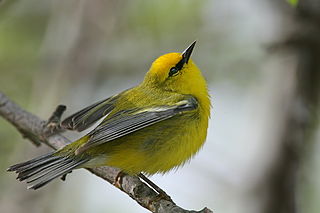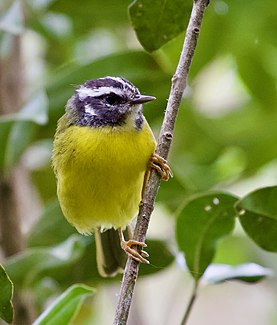
The New World warblers or wood-warblers are a group of small, often colorful, passerine birds that make up the family Parulidae and are restricted to the New World. They are not closely related to Old World warblers or Australian warblers. Most are arboreal, but some, like the ovenbird and the two waterthrushes, are primarily terrestrial. Most members of this family are insectivores.

The hooded warbler is a New World warbler. It breeds in eastern North America and across the eastern United States and into southernmost Canada (Ontario). It is migratory, wintering in Central America and the West Indies. Hooded warblers are very rare vagrants to western Europe.

The golden-crowned warbler is a small New World warbler.

Wilsonia is a small genus of New World warblers which breed in North America. They are migratory, wintering south of their breeding ranges in Central America, the West Indies or South America.

Setophaga is a genus of birds of the New World warbler family Parulidae. It contains at least 33 species. The males in breeding plumage are often highly colorful. The Setophaga warblers are an example of adaptive radiation with the various species using different feeding techniques and often feeding in different parts of the same tree.

Cardellina is a genus of passerine birds in the New World warbler family Parulidae. The genus name Cardellina is a diminutive of the Italian dialect word Cardella for the European goldfinch.

Basileuterus is a genus of New World warblers, best represented in Central and South America. This is one of only two warbler genera that are well represented in the latter continent. Some species formerly considered in this genus are now placed in the genus Myiothlypis. It is likely that the ancestors of this genus colonised South America from the family's heartland in northern Central America even before the two continents were linked, and subsequent speciation provided most of the resident warbler species of that region.

Vermivora is a genus of New World warblers.

Kloss's leaf warbler is a leaf warbler found in Cambodia, China, Laos, Thailand, and Vietnam. Its natural habitats are temperate forests, subtropical or tropical moist lowland forests, and subtropical or tropical moist montane forests.

The green-crowned warbler is a species of leaf warbler. It was formerly included in the "Old World warbler" assemblage.

The chestnut-crowned warbler is a species of leaf warbler. It was formerly included in the "Old World warbler" assemblage.

The grey-crowned warbler is a species of Old World warbler in the family Phylloscopidae. It is found in Bangladesh, China, India, Laos, Myanmar, Thailand and Vietnam. Its natural habitats are temperate forests, subtropical or tropical moist lowland forest, and subtropical or tropical moist montane forest.

The Santa Marta warbler is a species of bird in the family Parulidae. It is endemic to the Santa Marta Mountains in Colombia.

The golden-bellied warbler is a South American species of bird in the family Parulidae. Its natural habitats are subtropical or tropical moist lowland forests, subtropical or tropical moist montane forests, and heavily degraded former forest.

The three-striped warbler is a species of bird in the family Parulidae. It was previously considered conspecific with the Tacarcuna warbler and the black-eared warbler.

The green-tailed warbler, also known as the green-tailed ground warbler, is a species of songbird endemic to the island of Hispaniola and adjacent islets. It has occurred as a vagrant on the Turks and Caicos Islands.

The white-winged warbler, also called Hispaniolan highland-tanager, is a species of bird classified in the family Phaenicophilidae. It is the only member of the genus Xenoligea, and is found solely on Hispaniola.

The waterthrushes are a genus of New World warbler, Parkesia. The genus was split from Seiurus, which previously contained both waterthrush species and the ovenbird. When the genera split, the ovenbird was the only member left in Seiurus.

The black-eared warbler or Costa Rican warbler is a species of bird in the family Parulidae. It was previously considered conspecific with the three-striped warbler and the Tacarcuna warbler.
The Tacarcuna warbler is a species of bird in the family Parulidae. It was previously considered conspecific with the three-striped warbler, and the black-eared warbler.



















